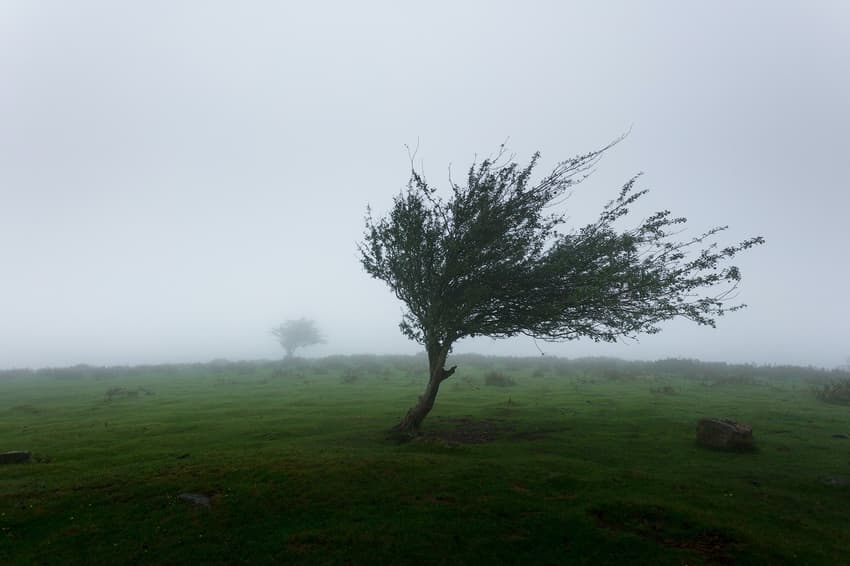Strong winds expected with storm Otto to hit southern Norway

Southern Norway can expect strong winds, and weather warnings are in place with Storm Otto arriving on Friday afternoon.
An orange weather warning is in place, and gusts of up to 40 metres per second are expected in parts of southern Norway as storm Otto reaches Norwegian shores.
The strongest winds are expected in Sunnhorland, in southwestern Norway. However, in the counties of Adger and Telemark, strong winds of up to 25 metres per second are also likely. Coastal areas will see winds of up to 40 metres per second.
Friday’s weather warning is in place from 2pm to 7pm or midnight, depending on where one lives. As a result, the public has been asked to secure loose objects that can be lifted away by the winds.
“Secure all loose objects, avoid traffic in exposed areas, calculate extra time for transport and driving, and assess whether the journey is necessary,” The Meteorological Institute warns.
The orange weather warning also covers the cities of Stavanger and Kristiansand. You can see a map of the weather warning below.
Vi har oppdatert det gule og oransje farevarselet for deler av Vestlandet ⚠️ Det ventes svært kraftige vindkast for deler av Sunnhordland, Rogaland, Telemark og hele Agder.
Les mer og hold deg oppdatert 👇https://t.co/A9UInW0gvG pic.twitter.com/nEjNP4QhC3
— Meteorologene (@Meteorologene) February 17, 2023
In addition, travellers have been told to expect cancelled ferry, plane and other transport departures. Furthermore, roads and bridges may be closed due to the strong winds. The power supply could also be affected by trees being blown onto powerlines, and high waves could damage infrastructure near the sea.
State meteorologist Alexander Skeltved has also said that parents may need to consider picking their small children up from school and kindergarten rather than letting them walk home.
“People have to think about it. It can be quite scary. They should take this into account when picking up children from nursery school or school and think about whether children should go home alone,” he told regional publication Bergens Tidende.
Comments
See Also
An orange weather warning is in place, and gusts of up to 40 metres per second are expected in parts of southern Norway as storm Otto reaches Norwegian shores.
The strongest winds are expected in Sunnhorland, in southwestern Norway. However, in the counties of Adger and Telemark, strong winds of up to 25 metres per second are also likely. Coastal areas will see winds of up to 40 metres per second.
Friday’s weather warning is in place from 2pm to 7pm or midnight, depending on where one lives. As a result, the public has been asked to secure loose objects that can be lifted away by the winds.
“Secure all loose objects, avoid traffic in exposed areas, calculate extra time for transport and driving, and assess whether the journey is necessary,” The Meteorological Institute warns.
The orange weather warning also covers the cities of Stavanger and Kristiansand. You can see a map of the weather warning below.
Vi har oppdatert det gule og oransje farevarselet for deler av Vestlandet ⚠️ Det ventes svært kraftige vindkast for deler av Sunnhordland, Rogaland, Telemark og hele Agder.
— Meteorologene (@Meteorologene) February 17, 2023
Les mer og hold deg oppdatert 👇https://t.co/A9UInW0gvG pic.twitter.com/nEjNP4QhC3
In addition, travellers have been told to expect cancelled ferry, plane and other transport departures. Furthermore, roads and bridges may be closed due to the strong winds. The power supply could also be affected by trees being blown onto powerlines, and high waves could damage infrastructure near the sea.
State meteorologist Alexander Skeltved has also said that parents may need to consider picking their small children up from school and kindergarten rather than letting them walk home.
“People have to think about it. It can be quite scary. They should take this into account when picking up children from nursery school or school and think about whether children should go home alone,” he told regional publication Bergens Tidende.
Join the conversation in our comments section below. Share your own views and experience and if you have a question or suggestion for our journalists then email us at [email protected].
Please keep comments civil, constructive and on topic – and make sure to read our terms of use before getting involved.
Please log in here to leave a comment.